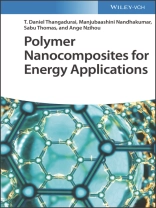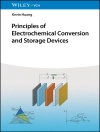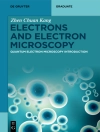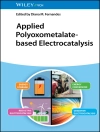Polymer Nanocomposites for Energy Applications
Explore the science of polymer nanocomposites and their practical use in energy applications
In Polymer Nanocomposites for Energy Applications, a team of distinguished researchers delivers a comprehensive review of the synthesis and characterization of polymer nanocomposites, as well as their applications in the field of energy. Succinct and insightful, the book explores the storage of electrical, magnetic, and thermal energy and hydrogen. It also discusses energy generation by polymer-based solar cells. Finally, the authors present a life cycle analysis of polymer nanocomposites for energy applications and provide four real-world case studies where these materials have been successfully used.
Readers will also find:
- Thorough introductions to the origins and synthesis of polymer materials
- In-depth discussions of the characterization of polymeric materials, including UV-visible spectroscopy
- Comprehensive explorations of a wide variety of polymer material applications, including in biotechnology and for soil remediation
- Fulsome presentations of polymer nanocomposites and their use in energy storage systems
Perfect for materials and engineering scientists and polymer chemists, Polymer Nanocomposites for Energy Applications will also earn a place in the libraries of professionals working in the chemical industry.
Inhoudsopgave
1 ORIGIN OF POLYMER MATERIALS
1.1 History of polymers
1.2 Types of Polymers
1.3 Properties of Polymers
1.4 Physicochemical Properties of Polymers
2 SYNTHESIS OF POLYMERS
2.1 Features of the Polymerization Reactions
2.2 Chain Polymerization
2.3 Ring-opening Polymerization
2.4 Polycondensation
2.5 Polyaddition
2.6 Step-growth Polymerization
2.7 Dendrimers
2.8 Anionic Polymerization
2.9 Cationic Polymerization
2.10 Controlled Radical Polymerization
2.11 Atom Transfer Radical Polymerization (ATRP
2.12 Reversible Addition Fragmentation Chain Transfer (RAFT)
2.13 Supramolecular Polymerization
2.14 Bulk Polymerization
2.15 Solution Polymerization
2.16 Suspension Polymerization
2.17 Methods for the Synthesis of Functional Polymers
2.18 Polymer Nanoparticles
2.19 Polymer Nanoparticle Synthesis Techniques
3 CHARACTERIZATION OF POLYMERIC MATERIALS
3.1 Introduction
3.2 UV-Visible Spectroscopy
3.3 Elemental Analysis
3.4 Infrared Spectroscopy
3.5 Qualitative Analysis of Polymers
3.6 IR Spectra analysis for Polyethylene
3.7 Determination of Molecular Weights and Thermodynamic Properties
3.8 Differential Scanning Colorimetry (DSC) Analysis
3.9 Thermogravimetric Assays (TGA)
3.10 Gel Permeation Chromatography (GPC)
3.11 High-Performance Liquid Chromatography (HPLC)
3.12 Size Exclusion Chromatography (SEC)
3.13 Raman Spectroscopy
3.14 Mechanical Testing and Rheometry
3.15 Nuclear Magnetic Resonance Spectroscopy
3.16 X-ray Diffraction
3.17 Molar Mass and Molar-Mass Distribution
3.18 Osmometry
3.19 Mass spectrometry
3.20 Scanning Electron Microscopy (SEM)
3.21 Transmission Electron Microscopy (TEM)
3.22 Atomic Force Microscopy (AFM)
3.23 Optical Microscopy (OM)
4 DIVERSE APPLICATIONS OF POLYMER MATERIALS
4.1 Broad Area of Polymer Applications
4.2 Polymers in Biotechnology
4.3 Polymer Dielectrics for Electronics
4.4 Smart and Self-healing Coatings
4.5 Polymeric Biocides and Herbicides
4.6 Polymers for Soil Remediation
4.7 Benefits of Polymers in Fabric and Home-care Formulations
4.8 Polymeric Materials for Photonics
4.9 Polymers for Electrophotography
4.10 Polymers in Energy Applications
4.11 Polymers in Construction Applications
4.12 Polymers in Automobile Applications
5 NANOMATERIALS: TYPES, SYNTHESIS, APPLICATIONS
5.1 Nanotechnology
5.2 Nanomaterials
5.3 Types of Nanomaterials
5.4 Synthesis of Nanoparticles
5.5 Applications of Nanomaterials
6 NANOCOMPOSITE MATERIALS: TYPES, CHARACTERIZATION, APPLICATIONS
6.1 Class of Nanocomposites
6.2 Different Types of Nanocomposites
6.3 Nanocomposite Synthesis Methods
6.4 Nanocomposite Characterization Techniques
6.5 Applications of Nanocomposite Materials
7 POLYMER NANOCOMPOSITES IN ENERGY STORAGE SYSTEMS
7.1 Introduction
7.2 Batteries
7.3 Thermal
7.4 Mechanical Storage
7.5 Hydrogen
7.6 Pumped Hydropower
7.7 Flywheels
7.8 Role of Polymer Nanocomposites in Energy Storage Applications
7.9 Properties of Polymer Nanocomposites
8 POLYMER NANOCOMPOSITES FOR RENEWABLE ENERGY STORAGE SYSTEMS
8.1 Renewable Energy Storage
8.2 Polymers for Energy Storage
8.3 Carbon-based Storage Materials
8.4 Energy Storage Capability of Polymer Nanocomposites
9 HIGH-PERFORMANCE INORGANIC POLYMER-NANOCOMPOSITES BASED SOLAR CELLS
9.1 Introduction
9.2 Organic-Organic Composites
9.3 Inorganic Nanocomposites
9.4 Nanocomposites in Perovskite Solar cells
9.5 Polymeric nanocomposites in Dye-sensitized Solar Cells (DSCs)
10 POLYMER-NANOCOMPOSITES FOR MAGNETIC ENERGY AND THERMAL ENERGY STORAGE
10.1 Background of Polymer Nanocomposites for Energy Storage
10.2 Energy Density
10.3 Superconducting Magnetic Energy Storage (SMES)
10.4 Thermal energy storage (TES)
10.5 Nanocomposite Capacitors
11 POLYMER-NANOCOMPOSITES FOR TRIBOELECTRICITY AND HYDROGEN STORAGE
11.1 Polymer-Nanocomposites for Triboelectricity
11.2 Polymer Nanocomposites for Hydrogen storage
11.3 Hydrogen based Energy Storage System
12 POLYMER NANOCOMPOSITES FOR SUPERCAPACITORS AND BATTERY APPLICATION
12.1 Battery based Energy Storage System
12.2 Types of Battery
12.3 Conducting Polymer Nanocomposites
12.4 Fuel Cells
12.5 Capacitor and Supercapacitor Energy Storage
13 ELECTROCHEMICAL ENERGY STORAGE SYSTEMS
13.1 Introduction
13.2 Need for Energy Storage Systems
14 LIFE CYCLE ANALYSIS OF POLYMER NANOCOMPOSITES FOR ENERGY STORAGE
14.1 Scope of a Life Cycle Analysis
14.2 Techno-economic Evaluations of Energy Storage Systems
14.3 Energy and Power Density
14.4 Self-Discharge
14.5 Response Time
14.6 Cost and Economies of Scale
14.7 Lifetime
14.8 Storage Capacity
14.9 Monitoring and Control Equipment
14.10 Efficiency
14.11 Operating Constraints
15 FUTURE RESEARCH AND CASE STUDIES ON ENERGY STORAGE SYSTEM
15.1 Introduction
15.2 Case study 1: Pumped Storage Hydropower (PSH) in France
15.3 Case study 2: Battery Storage
15.4 Case study 3: Solar PV Storage and Energy Shift
15.5 Case study 4: Solar and Battery Storage for the Customer and Ancillary Services
Over de auteur
T. Daniel Thangadurai is Professor in the Department of Chemistry at KPR Institute of Engineering and Technology in India.
Manjubaashini Nandhakumar is Research Associate in the National Centre for Nanoscience and Nanotechnology at the University of Madras, India.
Sabu Thomas is Vice Chancellor of Mahatma Gandhi University in Kerala, India, as well as the Founder and Director of the International and Interuniversity Centre for Nanoscience and Nanotechnology.
Ange Nzihou is a Distinguished Professor of Chemical Engineering at the Research Centre for Particulate Solids, Energy, and Environment, RAPSODEE-CNRS at IMT Mines Albi, France.












